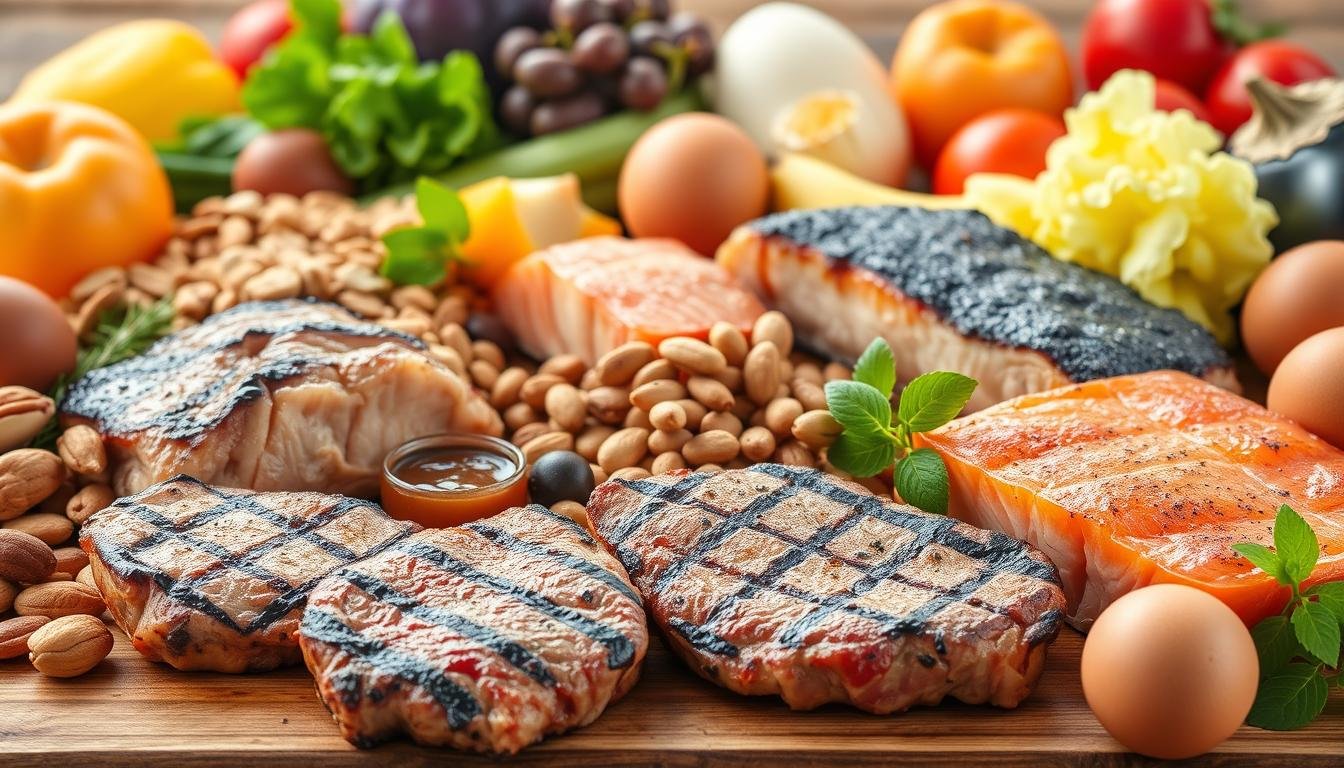Could swapping meat for more plants unlock a lifestyle that boosts energy, reduces disease risk, and protects the planet? The plant-based diet has surged in popularity—but what does it really mean to eat this way? This guide answers those questions and more.
Discover how a plant-based diet reshapes nutrition, from lowering heart disease risks to cutting carbon footprints. Learn practical steps to transition, avoid common pitfalls, and enjoy meals packed with flavor and science-backed benefits.
Key Takeaways
- Plant-based diets prioritize whole foods like fruits, vegetables, grains, and legumes.
- Research links the health benefits of plant-based diet to lower rates of chronic illnesses.
- Transitioning can start with small swaps like meatless Mondays or exploring global cuisines.
- Key nutrients like protein and iron are achievable through plant sources with proper planning.
- Long-term success depends on balancing nutrition and enjoying diverse meal options.
What is a Plant-Based Diet?
A plant-based diet focuses on foods from plants like fruits, vegetables, grains, and legumes. It can be strict or flexible, depending on the person. The main goals are health, sustainability, and being kind to animals.
Definition and Key Principles
This diet mainly emphasizes:
- Fresh produce and foods that are not heavily processed
- Using fewer animal products
- Choosing foods that are good for the planet and animals
Comparison to Other Diets
It stands out from other diets in several ways:
| Diets | Animal Products Allowed | Focus |
|---|---|---|
| Plant-Based Diet | Varies (flexible options) | Health and sustainability |
| Vegan Diet | None | Ethical and environmental principles |
| Vegetarian | Dairy/eggs allowed | Plant-centric with animal byproducts |
| Mediterranean | Fish and occasional meat | Balanced whole foods |
| Paleo | Meat and fish | Emulates ancestral eating patterns |
Knowing these differences helps people choose what’s best for them. It could be for health or because they care about animals and the planet.
Benefits of a Plant-Based Diet
Choosing a plant-based lifestyle brings many benefits. It improves your health and helps the planet. Here’s how it makes a difference in three key areas.
Health Benefits for the Body
Research shows that a plant-based diet can lead to a longer life. Studies have found:
- It can lower heart disease risk by up to 42% compared to diets rich in meat.
- It may reduce the chance of type 2 diabetes in long-term plant eaters.
- It boosts gut health thanks to fiber from foods like beans and whole grains.
The American Heart Association agrees. They say plant-based diets help fight obesity and high blood pressure.
Environmental Advantages
Switching to sustainable eating helps the environment a lot. Animal farming takes up 83% of farmland and creates 60% of greenhouse gases. Plant-based diets use 50% less water and reduce deforestation.
A 2023 UN report says this change could lower global emissions by 7.3 gigatons each year.
“Every bite of plant-based food is a vote for a healthier planet.”
Ethical Considerations
This diet choice also supports animal welfare. Over 70 billion animals are raised for food each year in industrial farms. Groups like the Humane Society promote plant-based eating to lessen animal suffering.
Whether you care about your health, the planet, or animal rights, this lifestyle is a game-changer. It’s supported by science and backed by global efforts.
Nutritional Essentials in a Plant-Based Diet
Creating a balanced plant-based nutrition plan means focusing on key nutrients. These are often found in animal products. A well-thought-out plant-based diet can cover all nutritional bases with the right food choices and planning.
Key nutrients to focus on include protein, iron, calcium, vitamin B12, and omega-3s. Plant proteins like lentils, chickpeas, and tofu offer amino acids. Dark leafy greens such as spinach and broccoli are good sources of iron and calcium. Walnuts and chia seeds are great for omega-3s.
- Protein: Tempeh, quinoa, and edamame
- Iron: Lentils, fortified cereals, and pumpkin seeds
- Vitamin B12: Nutritional yeast, fortified plant milks
Without careful planning, deficiencies can happen. Vitamin B12 is hard to find in plant foods, so fortified products or supplements are key. Eating iron-rich foods with vitamin C, like spinach with citrus, helps iron absorption. Omega-3s from flaxseeds or algae-based supplements can fill the gaps.
Regular blood tests can spot deficiencies early. Eating a variety of whole foods ensures a diet full of vitamins and minerals. This supports long-term health.
Getting Started with a Plant-Based Diet
Starting a plant-based lifestyle is easy with small steps. You can aim for a full meatless diet or just add more plants. These tips help you transition smoothly without feeling overwhelmed.
Tips for Transitioning
Start with small changes:
- Begin with one plant-based meal a day, like using tofu in stir-fries.
- Join the global “Meatless Monday” movement to make it a habit.
- Try adding more veggies, grains, and legumes before cutting down on animal products.
“Transitioning gradually builds habits that stick,” says registered dietitian Dr. Sarah Green. “Celebrate progress, not perfection.”
Meal Planning Strategies
Plan meals with these tips:
- Use the plate method: Fill half with veggies, a quarter with whole grains, and a quarter with protein.
- Batch-cook meals like chili or grain bowls on weekends for quick meals.
- Try plant-based brands like Beyond Meat or Gardein for familiar tastes.
Stocking Your Pantry
Stock up on these essentials for easy cooking:
- Grains: oats, barley, farro
- Legumes: canned chickpeas, lentils, black beans
- Protein-rich snacks: roasted edamame, nuts, or energy bars
- Alternatives: almond milk, nutritional yeast, and flaxseed for texture.
With these tips, you’ll create a solid base for a plant-based lifestyle. Every step you take is a step in the right direction!
Plant-Based Meal Ideas
Discover how easy it is to enjoy flavorful meals with these plant-based recipes. From morning to night, the plant-based diet offers endless possibilities:
Breakfast Options
- Overnight oats with chia seeds and berries
- Tofu scramble with turmeric and spinach
- Frozen banana “nice cream” with cocoa powder
- Whole-grain waffles topped with almond butter and sliced fruit
Lunch Recipes
Boost midday energy with:
- Quinoa salads with roasted veggies and tahini dressing
- Chickpea wraps stuffed with avocado and pickled onions
- Lentil soups packed with carrots and spinach
- Grain bowls layered with farro, kale, and roasted sweet potatoes
Dinner Inspirations
Try these satisfying dishes:
- Black bean chili with cornbread on the side
- Eggplant lasagna using cashew cheese
- Stir-fried tofu with broccoli and peanut sauce
- Zucchini noodles tossed in marinara and nutritional yeast
Snack Suggestions
Healthy bites that hit the spot:
- Hummus with veggie sticks
- Dark chocolate-covered nuts
- Rice cakes topped with mashed avocado
- Trail mix combining dried fruit and seeds
These ideas prove the plant-based diet can be both nourishing and exciting. Mix and match ingredients to suit your taste—creativity keeps meals fresh!
Overcoming Common Challenges
Switching to a plant-based lifestyle can be tough. Cravings, eating out, and social events can test your resolve. Here are tips to help you stay on track without giving up.
Managing Cravings
It’s normal to crave foods like cheese or burgers. Try plant-based alternatives like jackfruit “pulled pork” or cashew-based sauces. Keep a food journal to track your cravings.
Slowly reduce salt and sugar to change your taste buds. Explore new flavors like roasted veggies or spicy lentil dishes.

Dining Out
Many restaurants now have meatless diet options. Use apps like HappyCow to find them. Always ask servers about making changes to your meal.
For example, ask for a burger without the patty but keep the toppings. Most dishes can be adapted with simple requests.
“The best strategy is to assume options exist and ask boldly.”
Social Situations
- Bring a dish to gatherings to ensure options.
- Politely explain your choice without overexplaining.
- Plan ahead for holidays or travel with snacks.
Join online communities like Forks Over Knives forums for support. Celebrate small wins to stay motivated.
Plant-Based Diet Myths Debunked
Plant-based nutrition often faces misunderstandings that discourage people from trying it. Let’s address three common myths to clarify facts and benefits.
Protein Concerns
Myth: Vegetarian diets lack sufficient protein. Reality: Plant proteins like beans, lentils, and tofu provide all essential amino acids when eaten throughout the day. The USDA recommends 0.8g protein per kg of body weight—easily met with varied plant-based meals. Quinoa and chickpeas offer complete proteins, while combining grains and legumes ensures balanced intake.
Misconceptions about Nutrients
Myth: Plants can’t supply key vitamins/minerals. Reality: Calcium thrives in fortified plant milks and leafy greens like kale. Iron from spinach and fortified cereals is bioavailable when paired with vitamin C-rich foods. Vitamin B12, often cited as a gap, is found in fortified foods or supplements—common practice even in non-vegetarian diets.
Cost of a Plant-Based Diet
Myth: Eating vegetarian is expensive. Reality: Staples like beans (under $2/lb), oats, and seasonal veggies cost less than meat. A USDA study shows plant-based diets can reduce grocery bills by 30%. Prioritizing store sales and bulk purchases maximizes savings.
The Role of Supplements in a Plant-Based Diet
Plant-based diets are rich in vitamins and minerals. But, supplements can fill in the gaps. They boost the health benefits of a plant-based diet while staying true to its core.
When Are Supplements Necessary?
Think about supplements in these cases:
- Strict vegan diets lacking natural B12 sources
- Low sun exposure reducing vitamin D synthesis
- Pregnancy, aging, or medical conditions requiring extra nutrients
- Restricted food variety limiting iron or omega-3 intake
Recommended Supplements
| Supplement | Purpose | Typical Dosage |
|---|---|---|
| Vitamin B12 | Maintains nerve and blood cell health | 250–1000 mcg daily (cyanocobalamin form) |
| Vitamin D3 | Supports calcium absorption | 600–800 IU daily |
| Iron | Prevents deficiency in active individuals | 18 mg daily (non-heme sources) |
| Omega-3 ALA | Essential fatty acids for heart health | 220–2600 mg combined EPA/DHA via algae-based supplements |
Always talk to a healthcare provider before starting supplements. Use them alongside whole foods for the best plant-based nutrition.
How to Read Food Labels for Plant-Based Living

Living a vegan or plant-based life means you need to get good at reading labels. Animal products can hide in many foods. It’s important to know how to find them and make smart choices.
Understanding Ingredients
First, look at the ingredient list for animal terms. Check for “Certified Vegan” labels from Vegan Society or Vegan Action. Stay away from items with these words:
- Gelatin (from bones)
- Cochineal extract (from insects)
- Casein or whey (milk proteins)
Identifying Hidden Animal Products
Some products use tricky names. Watch out for these:
- Lard or tallow (animal fats)
- Isinglass (fish bladders)
- Shellac (secretions from insects)
“Natural flavors” might also include animal parts. Use apps like Yuka or FoodSwitch to check barcodes fast. Keep a list of tricky terms on your phone for quick checks.
If you’re unsure, call the company. Many list ingredients online. Being careful is key for your health and values.
Successful Long-Term Adherence
Starting a plant-based lifestyle is more than just a short-term goal. It’s about building lasting habits and having a supportive community. Small, steady changes and connections with others can turn daily choices into lasting habits.
Building Healthy Habits
Begin with habit stacking: link new habits to your current routines. For example:
- Add a handful of berries to your morning coffee
- Switch one meal a day to legume-based dishes
Organize your kitchen to make plant-based foods more accessible. Embracing a sustainable eating identity helps keep you on track. Remember, setbacks are chances to learn, not failures.
Support Systems and Resources
Look for online groups like Vegan Mainstream or local meetups. Dietitians like VeganRD can provide personalized advice.
Here are some tools to help you stay connected:
- Apps: HappyCow for finding restaurants, Cronometer for tracking nutrients
- Books: “The Game Changers” documentary and “Thrive” by Brendan Brazier
- Websites: NutritionFacts.org for reliable nutrition information
Involving your family can boost your commitment. Plan meals together using books like “Oh She Glows Every Day” for simple recipes. Celebrate your successes to keep your motivation up.
Plant-Based Diets Across Cultures
Plant-based eating is a big part of many cultures around the world. In India, you’ll find spice-rich curries. In Japan, there’s the simple yet elegant shojin ryori. These dishes use local ingredients and reflect the history and beliefs of each place.
Global Perspectives on Plant-Based Eating
Where you are in the world affects how you eat plant-based:
- India: Over 30% of the population eats vegetarian, thanks to Hinduism and Jainism.
- Mediterranean regions: You’ll find dishes like Greek moussaka and Spanish fabada, rich in olive oil, legumes, and herbs.
- East Asia: In Japan, Buddhist temples serve shojin ryori. China uses mock meats in its Buddhist vegetarian dishes.
- Africa: West African waakye and Ethiopian injera flatbread show the importance of grains in their cuisine.
Unique Dishes to Explore
Here are some vegetarian dishes from around the world:
| Dish | Origin | Ingredients |
|---|---|---|
| Ethiopian doro wat | Ethiopia | Spiced chickpeas, berbere spice, injera |
| Japanese shojin ryori | Japan | Miso, tofu, seasonal vegetables |
| Mexican chiles rellenos | Mexico | Poblano peppers stuffed with spiced rice |
Exploring these plant-based recipes shows how different cultures add to our food choices. From Middle Eastern hummus to Thai pad Thai with tofu, there’s always something new to try.
The Future of Plant-Based Diets
The plant-based movement is growing, changing how we eat and see food systems. As sustainable eating becomes more popular, new ideas and rules are shaping what it means to live a plant-based lifestyle. Let’s look at where this journey is going.
Trends to Watch
Technology is leading to big changes, like lab-grown meat from Memphis Meats and better plant-based burgers from Beyond Meat. Apps like Forks Over Knives and Noom use AI to create meal plans just for you. These changes show a move toward smarter, greener choices.
Impact on Public Health Policy
Guidelines from the USDA and WHO are pushing for more plant-based diets. Hospitals like Kaiser Permanente are offering plant-based options to fight chronic diseases. Soon, farmers might get paid to grow more legumes and grains, helping health and the environment.
By making these choices, we help create a healthier world. We’re not just talking about food anymore. We’re building a culture that supports both people and the planet.



